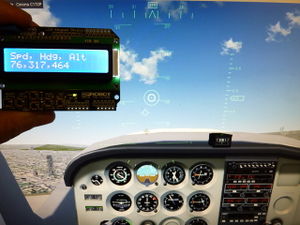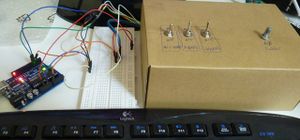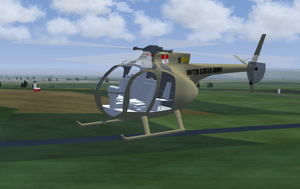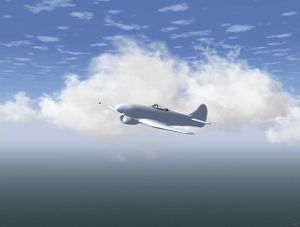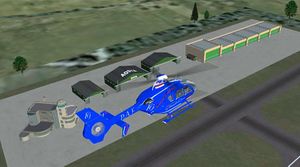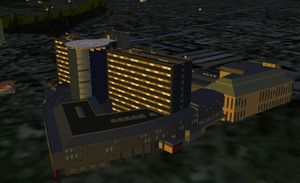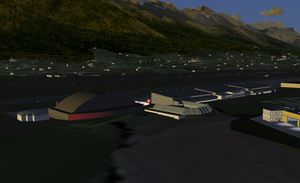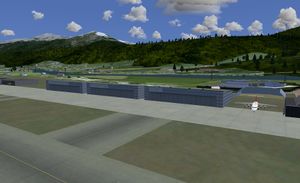FlightGear Newsletter February 2011
|
We would like to emphasize that the monthly newsletter can not live without the contributions of FlightGear users and developers. Everyone with a wiki account (free to register) can edit the newsletter and every contribution is welcome. So if you know about any FlightGear related projects such as for example updated scenery or aircraft, please do feel invited to add such news to the newsletter.
FlightGear Video Contest
Anticipating LinuxTag 2011, the most important place for Linux and open source software in Europe, a Video Contest has been started at the forum ![]() . We have strong evidence that, again FlightGear will be present at the show with its own booth and the FlightGear presentation team is looking for a video to present the best features of FlightGear in a short movie during the show.
. We have strong evidence that, again FlightGear will be present at the show with its own booth and the FlightGear presentation team is looking for a video to present the best features of FlightGear in a short movie during the show.
The creator of the chosen video wins one of the rare and famous FlightGear t-shirts, a pair of cool 3d-red-cyan glasses and free admission to the LinuxTag 2011 in Berlin, Germany. Deadline for entries is April, 24th 2011 12.00 UTC.
Read more at the forum ![]() .
.
Development news
Sound files for 3D Audio
There seems to be some confusion about what types of sound files are supported for 3D audio rendering. Let's explain a bit more about how 3D audio works.
A 3D audio, or spatialized audio, implementation consists of one listener (like the OpenGL viewer) and multiple audio sources. A listener is placed at a specific location and has an orientation (view direction). Sources are placed in the scene at their own location and have an emission direction which is used to calculate the sound cone for non omni-directional sounds (sound sources that sound louder in one direction and softer or even quiet in the opposite direction). Sound sources can best be seen as a single dot emitting sound waves.The relative positions of the sources and the listener is used to calculate where the sources should be positioned in the listeners sound sphere.
If a sound source would be anything but mono it is almost impossible to guess how to handle all the channels in 3D space;
- Do they get mixed together?
- Do the tracks get positioned with a slight offset to each other? This in effect means mixing them together when the source is not close to the listener.
- Do they get positioned at the same location but with a sound direction offset of 180⁰? This means mixing them together if the sound is omni-directional.
There is something to say for any of the choices but you can bet that if one of the three was chosen someone else comes by and wants it to be different.
For this reason it is specified that only mono files will be used for 3D audio processing and stereo files will be mixed using the stereo mixer instead.
Lightmaps supported
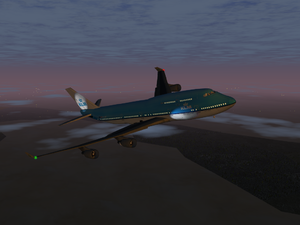
|
|
Gijs has been working on lightmap support in FlightGear, with the help of AndersG. Lightmaps are image files that define what pixels of a texture should be lit, how intense and what color. Ideal for night lights on liveries (no need to create a special lights .png file for each single livery; like we used to do) and cockpit panels. Currently there is very limited support for lightmaps. There is not yet a good conditional available for example, and it won't work in combination with other shaders (eg. no reflective lightmaps).
New software tools and projects
Arduino and FlightGear
Get a more real experience flying FlightGear using real instruments. Arduino is an open-source electronics prototyping platform based on flexible, easy-to-use hardware and software.
FlightGear's IO interface allows easy development of hardware that can improve the immersion and realism of the simulation. The output protocols allows hardware to act on simulation data in real time and at the same, the input protocol allows FlightGear to act on hardware events.
It takes minutes to have a LCD panel displaying speed, heading and altitude. Just as easy as creating a switchboard that would allow you to control:
- Landing Gear
- Flaps
- Rudder
- Hud on/off
- Airbrakes
- And more...
Sample code is available at Gitorious. Videos and and discussion can be found in two FlightGear forum topics: [1] ![]() [2]
[2] ![]()
OSS Linux headtrack for FlightGear
EasyHeadTrack is an addon for FlightGear that allows you to use a simple webcam in order to track the pilot position in the x,y and z axis. It is developed by Ralph Glass and Meir Michanie.
EasyHeadTrack just works out of the box:
- It is available for Linux
- Simple FlightGear interface.
- Configurable within FlightGear.
- Just works (no need to recalibrate when it looses track)
- Only webcam required, face tracking with opencv without any markers
- X,Y,Z axis supported
- Not quite as sensible as marker based solutions but good enough, so no need to wear a funny hat ;-)
EasyHeadTrack is available for download at Gitorious. Videos and updates can be found in the forum topic ![]() .
.
In the hangar
New aircraft
A small selection of aircraft of which development started in February.
OH-6 Cayuse
Icecode and Star have started developing the Hughes OH-6 Cayuse. OH-6 Cayuse (nicknamed "Loach", after the requirement acronym LOH - light Observation Helicopter) is a single-engine light helicopter with a four-bladed main rotor used for personnel transport, escort, attack missions, and observation.
Hawker Tempest V
Work is underway on the Hawker Tempest V. A "Hurricane on steriods" perhaps best known for its contribution to the anti-V1 campaign during 1944. It's a big brute of an aircraft capable of over 440 kts in a dive. The early models had the unfortunate habit of becoming detached from their tails. The Series 2 will be modelled here - that problem was considered to have been cured. Perhaps in the fullness of time we will add a V1 to the inventory to give a bit of target practice.
Updated aircraft
A small selection of aircraft updated in February.
Pilatus PC-21
pjedvaj and Johan G started to work on Pilatus PC-21. FDM will be the same as in original package with new systems and animations added. It has a new high-poly 3D model. New landing gear models and liveries are being developed. Final release will include all glass cockpit with MFD's and HUD. Temporary cockpit in this development stage has only a generic 2D panel.
Mikoyan-Gurevich MiG-21bis
pjedvaj resumed his work on Mikoyan-Gurevich MiG-21bis. Rudder issue is fixed and GSh-23 gun is now fully functional. Landing gear animations are now complete. Further development is concentrated on cockpit and instruments. New liveries are also on the way.
Liveries
Scenery corner
Airports
Aeroport Regional de la Vallee d'Aoste "Corrado Gex", Aosta (Italy)
Another small airport in the Alps, Aosta (Italy) to be precise, for those simmers who like VFR within mountains, like the Monte Bianco (Mont Blanc) and the Cervino (Matterhorn). The updating started with the extension of the taxiway to the end of rwy 27 (to reflect works recently done in the reality); the new LIMW.dat has been already forwarded to Martin.
The modelled buildings include:
- The control tower
- Three old fashioned hangars
- The new hangars (some 130 m long)
The sliding doors of the thre old hangars move to shutdown position at sunset (nasal script developed by ot-666). The above models are included in the scenery repository.
Innsbruck Hospital Heliport
This heliport (LOIU) is located on top of the main hospital building in Innsbruck, just a stone throw away from LOWI airport Austria and the LOJO oamtc helicopter base.
The model features night illumination and two-stage obstruction and helipad lights. Obstruction and helipad lights are activated at night and if the visibility is below 4500 meter. They switch to a higher setting for extreme low visibility conditions.
Thanks to the help of scighera the lights and the scenery model will work with FG 1.9.1 and up.
The model will be send to martin as soon as possible, but a preview version is already available at the forum ![]() .
.
Innsbruck Airport Hangar n1 - n3, n5 and Engine-test Building
The LOWI airport Austria now got new scenery models for the north hangar buildings. The models feature night illumination and two-stage obstruction lights.
The following models are included in the Repository by Martin:
- hangar n1
- hangar n2
- hangar n3
- hangar n5
- engine-test building
Community news
FlightGear on youtube
- i4dnf, author of the IAR 80, created a startup sequence video for that aircraft.
- Busting the Tower, uploaded by meirgotfirst.
And finally ...
The FlightGear presentation team is asking for your help! To be able to continue the excellent work at events like FSweekend and LinuxTag and to keep the allways growing equipment up-to-date and running, a PayPal account for donations has been set up.
If you think, they did a good job at presenting and promoting FlightGear and if you want to support them in having the best booth during the show, please consider donating a few Euros, Dollars, Pounds, Crowns, Yen, Francs, Afghanis, Dinars, Pesos or whatever your currency might be to donations@flightgear.org using PayPal.
All donations will be used for the sole purpose of adding to or maintaining the equipment used at the shows. Donations are not tax deductable yet.
Contributing
One of the regular thoughts expressed on the FlightGear forums is "I'd like to contribute but I don't know how to program, and I don't have the time". Unfortunately, there is a common misconception that contributing requires programming and lots of free time. In fact, there are a huge range of ways to contribute to the project without needing to write code or spending days working on something.
For ideas on starting to contribute to FlightGear, you may want to check out: Volunteer.
Call for volunteers
The OpenRadar project is looking for a new maintainer.
The TerraGear GUI project is looking for programmers to help create a GUI frontend for TerraGear [3] ![]() .
.
The FGFSPM (FlightGear Package Manager) is looking for a new maintainer.
Reminder: Google's Summer of Code 2011
FlightGear project is planning to participate in GSoC 2011. However, doing that really requires a fair amount of work, planning and organizing. This is not something that can be done by a single person. It really needs a coordinated team effort, or otherwise FlightGear won't be able to apply/participate at all, and has not participated in past years.
So all users are invited to help us progress further with our preparations for GSoC 2011. If you have any questions or other feedback, please use the forum to get in touch ![]() .
.
Thanks for reading FlightGear Newsletter February 2011

